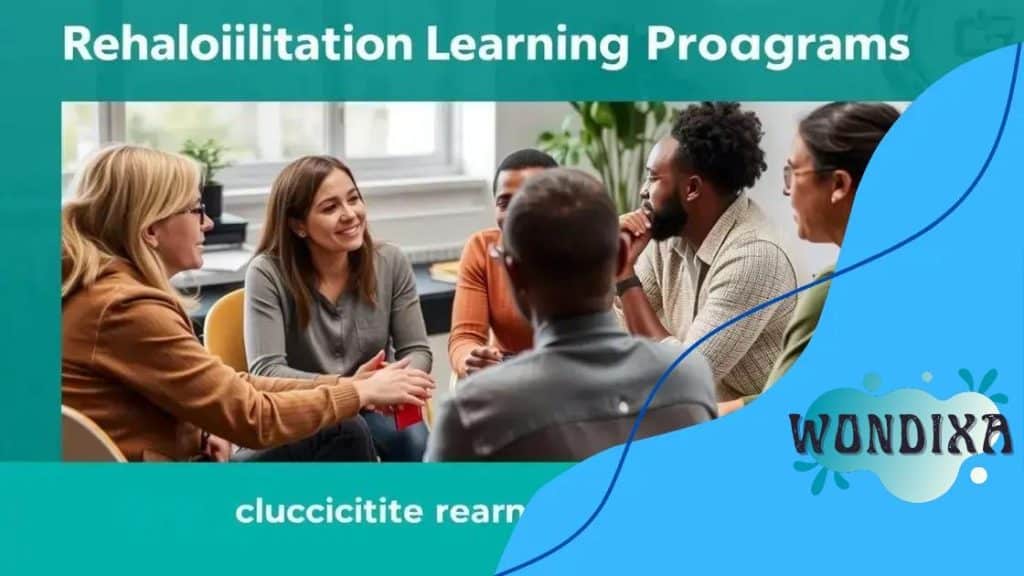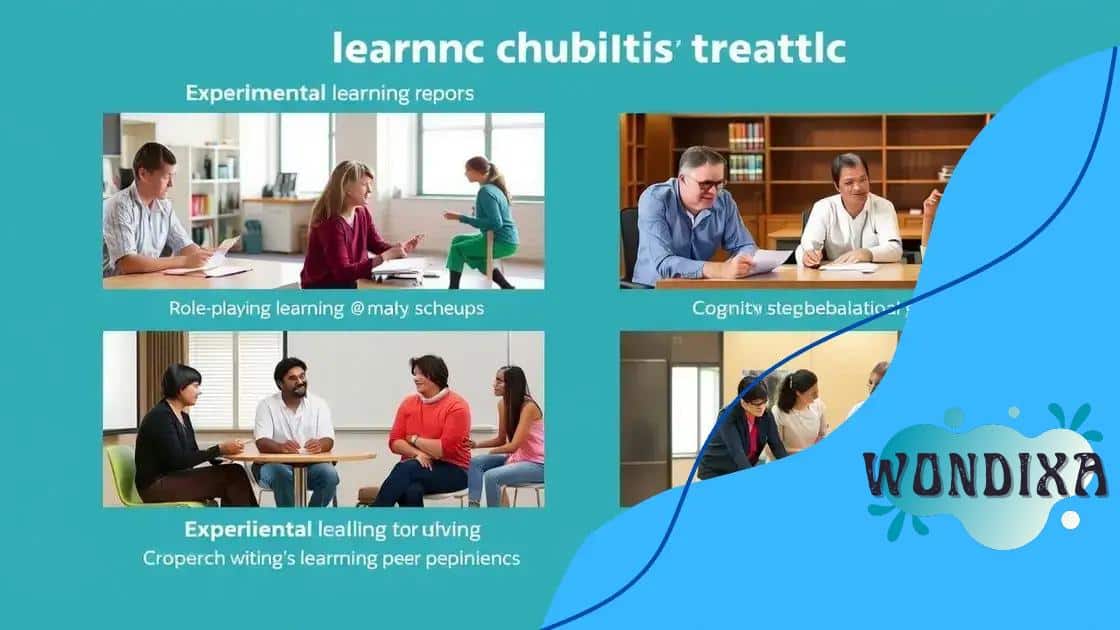Learning programs for rehabilitation: a fresh start

Learning programs for rehabilitation provide structured support and diverse learning strategies to help individuals recover from physical, mental health, or substance abuse challenges, ultimately enhancing their coping mechanisms and fostering personal growth.
Learning programs for rehabilitation play a crucial role in helping individuals regain their lives after challenging experiences. Have you ever considered how education can foster healing and growth? Let’s explore this transformative journey together.
Understanding rehabilitation programs
Understanding rehabilitation programs is essential for grasping their impact on individuals seeking recovery. These programs offer structured support tailored to various needs, whether related to physical injuries, mental health issues, or substance abuse. But how do these programs work, and what makes them effective?
The Structure of Rehabilitation Programs
Rehabilitation programs usually follow a systematic approach to help participants regain skills and confidence. They often begin with an assessment to identify specific needs and create a customized path for each individual. This adaptability ensures that everyone receives the best possible care.
In most cases, rehabilitation programs may include:
- Individual therapy sessions, focusing on personal challenges.
- Group activities that foster teamwork and mutual support.
- Skill-building workshops aimed at practical application.
- Continuous evaluation to track progress and make necessary adjustments.
Learning opportunities are integrated throughout the rehabilitation journey. Whether through counseling or educational sessions, participants gain insights that can facilitate healing. Engaging in discussions with peers further enriches the experience, allowing individuals to share their stories and lessons learned.
Types of Rehabilitation Programs
Although the goal of rehabilitation is often the same, there are various types of programs that cater to different aspects of recovery. Some focus on physical rehabilitation, while others target mental health or substance use disorders. Programs may be:
- Inpatient, providing intensive support within a facility.
- Outpatient, allowing individuals to receive care while living at home.
- Community-based, focusing on social reintegration.
- Private or public, depending on accessibility and resources available.
Ultimately, understanding rehabilitation programs means recognizing the diversity in approaches and the unique needs each participant brings to their recovery. With empathy and dedicated support, these programs can change lives and help individuals move towards a brighter future.
The role of learning in recovery
The role of learning in recovery is pivotal for those undergoing rehabilitation. It not only equips individuals with essential skills but also fosters a sense of empowerment and agency. Through education, participants can better understand their challenges and explore effective coping strategies.
Empowerment through Knowledge
Learning allows individuals to take an active role in their recovery. When they gain knowledge about their specific issues, they can make informed decisions that support their healing process. This can include:
- Understanding the psychological aspects of their condition.
- Exploring techniques for managing emotions and stress.
- Recognizing triggers and how to respond effectively.
- Building resilience through informed practices.
Additionally, educational workshops provide valuable tools that can change how individuals approach their recovery. For instance, they may learn about healthy lifestyle choices or the importance of maintaining social connections.
Interactive Learning Methods
Engaging and interactive learning methods help keep participants motivated. Utilizing group discussions, role-playing, and hands-on activities can make learning more effective. These methods often lead to deeper understanding and retention of information.
When individuals apply what they learn in real-life situations, they enhance their coping skills and cultivate a support network. This peer interaction is crucial, as sharing experiences fosters a sense of community and belonging. Supportive connections often become an integral part of the recovery journey.
Overall, the integration of learning into rehabilitation programs creates a pathway to lasting change. By focusing on education, individuals are better prepared to navigate their recovery, leading to improved outcomes and a renewed sense of purpose.
Types of learning strategies used

Using various learning strategies is crucial in rehabilitation programs for effective recovery. Different approaches cater to the diverse needs of individuals, helping them acquire new skills and insights that support their healing journey.
Experiential Learning
Experiential learning emphasizes hands-on experiences. Participants immerse themselves in real-life situations, which allows them to apply what they have learned. This method can include:
- Role-playing scenarios to practice coping strategies.
- Participating in community service activities to promote social skills.
- Workshops focused on creating art or engaging in physical activities to enhance creativity and movement.
By engaging with practical experiences, individuals build confidence in their abilities and learn how to navigate challenges effectively.
Cognitive Behavioral Techniques
Another effective strategy is the incorporation of cognitive behavioral techniques. These approaches focus on changing thought patterns, which can significantly impact behavior and emotional responses. Individuals may learn to:
- Identify negative thoughts and reframe them positively.
- Develop problem-solving skills for everyday challenges.
- Practice mindfulness techniques to stay present and manage anxiety.
Through these skills, individuals gain a deeper understanding of their thoughts and emotions, providing powerful tools for long-term recovery.
Additionally, social learning strategies play a significant role. In rehabilitation programs, observing and interacting with peers can enhance learning. Individuals may share their experiences, learn from each other, and practice new behaviors together.
Overall, utilizing a range of learning strategies ensures that rehabilitation programs meet individual needs and maximize recovery potential. Each approach offers unique benefits, paving the way for a holistic healing process that encourages growth and resilience.
Success stories from participants
Success stories from participants in rehabilitation programs showcase the transformative power of learning and support. These narratives highlight how individuals can overcome challenges and achieve personal growth through dedicated effort and guidance.
Transformative Journeys
Every success story starts with a journey, often marked by struggles and setbacks. For many, rehabilitation programs provide a structure and community that fosters hope and recovery. Participants frequently share experiences of initial uncertainty but find clarity through engaging with the program. Key elements of their journeys include:
- Gaining new skills that enhance daily functioning.
- Developing coping mechanisms that reduce anxiety.
- Building supportive relationships with peers and mentors.
- Achieving personal milestones, such as returning to work or reconnecting with family.
These journeys often emphasize the importance of resilience. Participants learn that setbacks are part of recovery and that perseverance leads to progress. Many report feeling inspired by their peers’ stories, which creates a sense of camaraderie and shared purpose.
Real-Life Examples
One powerful example is the story of Sarah, who struggled with substance use. Through a comprehensive rehabilitation program, she engaged in learning activities that equipped her with better decision-making skills. After several months, she not only overcame her challenges but also began mentoring new participants, sharing her journey and encouraging them.
Another participant, John, faced significant mental health issues. His story highlights the effectiveness of group therapy and cognitive behavioral techniques. By learning to identify his negative thought patterns, John transformed his outlook on life and established a stable routine that supported his mental well-being.
These success stories are not just personal achievements; they reflect the profound impact that rehabilitation programs can have on individuals and their communities. As more people share their journeys, the ripple effects of recovery and inspiration continue to grow.
Challenges in implementing programs
Challenges in implementing rehabilitation programs are common and often complex. Understanding these obstacles is crucial for creating effective solutions that meet the needs of participants. Many programs face issues related to resources, participant engagement, and individualized care.
Resource Limitations
One of the primary challenges is the availability of resources. Programs often struggle with budget constraints, which can limit access to necessary tools and trained staff. This can result in a lack of:
- Quality facilities that provide safe environments for activities.
- Educational materials and resources for effective learning.
- Trained professionals who specialize in various aspects of rehabilitation.
These limitations can hinder the overall effectiveness of the program and its ability to offer comprehensive care.
Engagement and Retention
Participant engagement is another significant challenge. Individuals entering rehabilitation may feel uncertain or resistant to the process. Reasons for this can include:
- Lack of motivation due to past failures in treatment.
- Fear of judgment from peers or staff.
- Difficulty in understanding the value of the program’s offerings.
To overcome these barriers, programs must actively create a welcoming environment that fosters trust and open communication. Building rapport with participants can encourage them to engage more fully in their recovery.
Individualized care is essential, but it can be hard to achieve. Every participant comes with unique experiences and needs. Programs may face difficulties in tailoring approaches that suit each individual while still managing group dynamics. Staff must be trained to identify specific needs while ensuring that all participants feel supported.
Addressing these challenges requires creativity, collaboration, and ongoing evaluation. By recognizing and tackling the barriers, rehabilitation programs can improve their effectiveness and enhance the recovery journey for all participants.
FAQ – Frequently Asked Questions about Rehabilitation Programs
What are rehabilitation programs designed to do?
Rehabilitation programs are designed to help individuals recover from challenges such as substance abuse, mental health issues, or physical injuries by providing structured support and learning opportunities.
How do learning strategies impact recovery in rehabilitation programs?
Learning strategies are crucial in rehabilitation as they empower participants with skills and knowledge to cope effectively, enhancing their overall recovery experience.
What common challenges do rehabilitation programs face?
Common challenges include resource limitations, engaging and retaining participants, and delivering individualized care to meet diverse needs.
Can participants share their success stories?
Yes, sharing success stories is encouraged as it inspires others and fosters a sense of community, highlighting the positive impact of rehabilitation programs.





